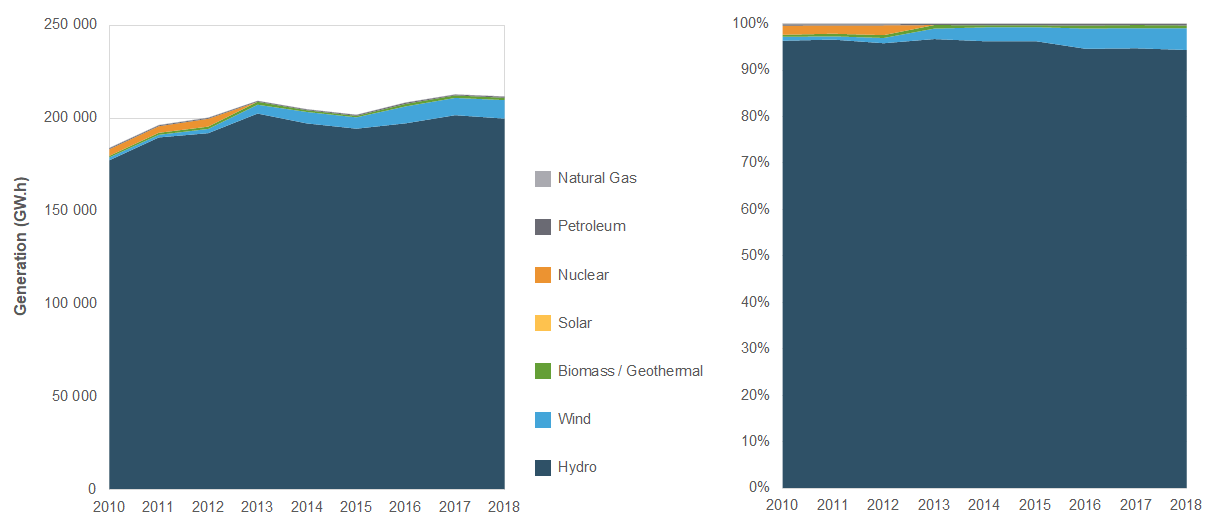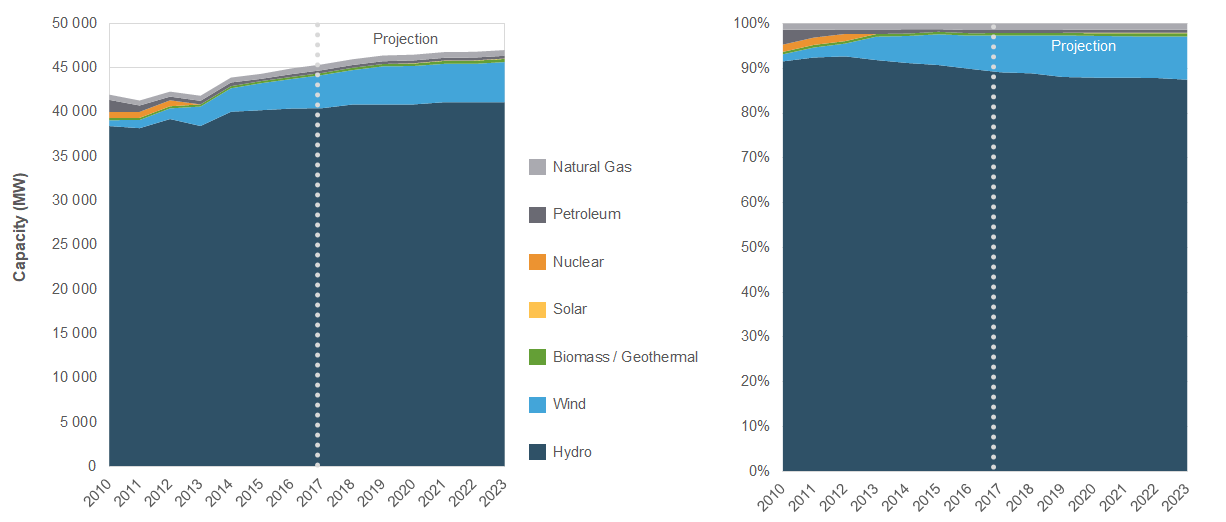Canada's Renewable Power – Quebec

Quebec
Hydro developments continue in Quebec, with the fourth and final Romaine River complex scheduled for completion in 2021. Quebec also saw strong growth in wind between 2010 and 2017, but this growth is expected to slow considerably over the medium term.
Generation Trends
Quebec is the largest generator of electricity in Canada. With large hydro resources scattered throughout the province, Quebec generates 94.3% of its electricity from hydro. Though non-hydro renewables such as wind and biomass account for a relatively small percentage of Quebec’s electricity generation mix (5.3%), Quebec is the second largest jurisdiction for wind generation in Canada (after Ontario) and the second largest jurisdiction for biomass in Canada (after British Columbia). Total renewable generation in 2018 was 210 989 gigawatt-hours (GW.h), or 99.6% of total generation.
Quebec is also the largest exporter of electricity in Canada, exporting a significant percentage of its own production and production from Labrador’s Churchill Falls.
A small amount of natural gas is used when demand is peaking, while diesel generators power remote communities in northern Quebec and the Magdalen Islands. Quebec ceased nuclear generation in 2012 when the Gentilly-2 Nuclear Generating Station was shut down. Total thermal generation in 2018 was 777 GW.h, or 0.4% of total generation.
Total electricity generation in Quebec grew from 184 141 GW.h in 2010 to 211 766 GW.h in 2018. Changes in Quebec’s electricity generation mix are illustrated in Figure 1.
Figure 1. Electricity Generation in Quebec

Source and Description
Source: CER – Canada’s Energy Future 2020 (EF2020)
Description: This graph illustrates electricity generation from 2010 to 2018 in Quebec. In 2010, Quebec’s total generation was 184 141 GW.h (97.6% renewable). In 2018, total generation was 211 766 GW.h (99.6% renewable).
GHG Emissions from Electricity Generation
In 2018, Quebec’s electricity sector emitted 0.3 megatonnes of carbon dioxide equivalent (MT of CO2e). Quebec’s generation intensity was 1.3 grams of CO2e per kilowatt-hour, tied with Manitoba for the lowest in Canada.
Quebec produced 0.4% of Canada’s total greenhouse gas emissions from electricity generation in 2018.
Recent and Projected Capacity Changes for Renewables
Between 2010 and 2017, Quebec added a net 5 100 megawatts (MW) of renewable capacity, primarily in the forms of wind (3 068 MW) and hydro (2 016 MW). Between 2017 and 2023, Quebec is projected to add 1 618 MW of new net renewable capacity. These capacity changes are illustrated in Figure 2 with data provided in Table 1.
Recent and future projects included in the projection are:
- Mesgi’g Ugju’s’n Wind Farm, which added 149 MW in 2017.
- Parc éolien Pierre-De Saurel, a wind project that added 25 MW in 2017.
- Roncevaux, a wind project that added 75 MW in 2017.
- Val-Éo, a wind project that added 24 MW in 2017.
- Mont Sainte-Marguerite, a wind project that added 147 MW in 2018.
- Nicolas-Riou Wind Farm, which added 224 MW in 2018.
- Des Cultures Wind Farm, which is expected to add 24 MW in 2020.
- La Prairie and Varennes, solar facilities that are expected to add 8 MW and 1.5 MW, respectively, in 2020.
- Hydro-Canyon Saint-Joachim, a peak hydro project that added 23 MW in 2017.
- Romaine 3, a hydro project that added 395 MW in 2017.
- Chute du Six Milles, a peak hydro project that added 13 MW in 2018.
- 11e chute rivière Mistassini, a peak hydro project that added 16 MW in 2018.
- Romaine 4, a hydro project that is expected to add 245 MW by 2021.
- A total of 110 MW from several biomass projects by 2023, including Windsor TG2, Complexe Boisaco, Valleyfield, and from provincial government mandates and targets.
When Romaine 4 is completed in 2021, the Romaine hydro project will have a total capacity of 1 550 MW and an average annual output of 8 000 GW.h.
Figure 2. Electricity Capacity and Future Changes in Quebec

Source and Description
Source: CER – EF2020
Description: This graph illustrates historical electricity capacity from 2010 to 2017 in Quebec and the CER’s projection of future capacity changes from 2018 to 2023. In 2010, Quebec’s total installed electricity capacity was 41 967 MW (93.7% renewable). In 2017, capacity had grown to 45 380 MW (97.9% renewable). By 2023, total capacity is projected to grow to 46 998 MW (98.0% renewable).
Table 1. Electricity Capacity (2010 – 2023) and Generation (2010 and 2018) in Quebec
| Capacity in MW and % | Generation in GW.h and % | ||||||
|---|---|---|---|---|---|---|---|
| 2010 | 2017 | 2018 | 2020 | 2023 | 2010 | 2018 | |
| ---------- Projected ---------- | |||||||
| Hydroelectricity | 38 426 | 40 442 | 40 853 | 40 866 | 41 111 | 177 402 | 199 783 |
| 91.6% | 89.1% | 88.9% | 87.9% | 87.5% | 96.3% | 94.3% | |
| Wind | 664 | 3 732 | 3 880 | 4 330 | 4 530 | 1 535 | 9 955 |
| 1.6% | 8.2% | 8.4% | 9.3% | 9.6% | 0.8% | 4.7% | |
| Biomass / Geothermal | 230 | 245 | 267 | 277 | 356 | 844 | 1 252 |
| 0.5% | 0.5% | 0.6% | 0.6% | 0.8% | 0.5% | 0.6% | |
| Solar | 0.0 | 0.3 | 0.3 | 40.3 | 40.3 | 0.0 | 0.0 |
| 0.9% | 0.8% | 0.8% | 0.8% | 0.8% | 0.5% | 0.4% | |
| All Renewable Sources | 39 320 | 44 420 | 45 000 | 45 513 | 46 037 | 179 781 | 210 989 |
| 93.7% | 97.9% | 97.9% | 97.9% | 98.0% | 97.6% | 99.6% | |
| Nuclear | 675 | 0 | 0 | 0 | 0 | 3 552 | 0 |
| 1.6% | 0.0% | 0.0% | 0.0% | 0.0% | 1.9% | 0.0% | |
| Natural Gas | 589 | 649 | 649 | 649 | 649 | 222 | 171 |
| 1.4% | 1.4% | 1.4% | 1.4% | 1.4% | 0.1% | 0.1% | |
| Oil and Diesel | 1 383 | 311 | 311 | 311 | 311 | 586 | 606 |
| 3.3% | 0.7% | 0.7% | 0.7% | 0.7% | 0.3% | 0.3% | |
| All Thermal Sources | 2 647 | 960 | 960 | 960 | 960 | 4 360 | 777 |
| 6.3% | 2.1% | 2.1% | 2.1% | 2.0% | 2.4% | 0.4% | |
| All Sources | 41 967 | 45 380 | 45 960 | 46 473 | 46 998 | 184 141 | 211 766 |
- Date modified:
